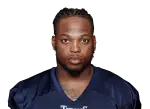For decades, most fantasy championships had a solid corp of running backs leading their teams. Whether studs from years past like LaDainian Tomlinson, Jamaal Charles, Barry Sanders, and Le'Veon Bell to modern-day point scorers like Christian McCaffrey, Jonathan Taylor, and Derrick Henry, the NFL feels different today. The workhorse running back is giving way to running back by committee (RBBC).
There will always be an opportunity for the bell cow (Derrick Henry for example averaged 312 carries/season over the last four years) but the RBBC approach allows the team to keep their starters better rested and reduce the amount of hits that they have to absorb in what is arguably the most punishing position in football. For most running backs, the workload has changed.
Just as the NFL is adapting to this new paradigm shift, fantasy owners would do well to take notice.
 Derrick Henry remains the king of workloads, and as long as he remains healthy, he should be a lock for 300+ touches in that Titans' offense again this season. The burning question is what other running backs can we reliably project for heavy volume (250+ touches) and how should we approach this position during our drafts?
Derrick Henry remains the king of workloads, and as long as he remains healthy, he should be a lock for 300+ touches in that Titans' offense again this season. The burning question is what other running backs can we reliably project for heavy volume (250+ touches) and how should we approach this position during our drafts?
The answer depends upon our scoring format and roster setup. For example, standard scoring leagues tend to favor the RB position, but perhaps the biggest factor is your league's roster setup. Do you start 2 receivers, 3 receivers, or some mix with a flex spot? If you have three or more receivers that you'll likely start each week, then the wide receiver position takes on more significance because that's another roster spot contributing each week.
Here's how we would approach the running back position on draft day.
Hero Running Back
All things considered, this is our preferred strategy. Taking a top-end RB with your first or second pick opens up some really interesting possibilities. It gives you that one bell cow while giving you flexibility with the receiver or tight end position. Looking at ADP data, let's assume you take Justin Jefferson or Ja'Marr Chase with your first round pick. You could pair him with someone like Derrick Henry, Tony Pollard, or Rhamondre Stevenson in the second. If you took Christian McCaffrey or Austin Ekeler in the first, you could pair them with someone like Amon-Ra St. Brown, Garrett Wilson, or Jaylen Waddle in the second. Either option sets you up well with solid anchors in those positions.
Zero Running Back
We have written about the Zero RB strategy before, and it essentially eschews the running back position in favor of receivers for the first few rounds. The rationale is based upon the sometimes inconsistent production from the position. To make this approach work, we need to find players in the mid-to-late rounds with comfortable upside. Looking at our Running Back Tiers, we're going to want to target guys like Dameon Pierce, Kenneth Walker, J.K. Dobbins, and Alexander Mattison in rounds 3 - 5. If you wait a few more rounds to pull the trigger on RB, you're looking at guys like D'Andre Swift, Cam Akers, Miles Sanders, James Conner, David Montgomery, Javonte Williams, and Isiah Pacheco. Workloads remain a question mark in these rounds and later...but it can work. At first blush, it may seem difficult to get excited about any of these guys as your starting RB, but there is plenty of upside to all of them. It's also the trade-off on waiting.
Again, we tend to lean towards the Hero RB approach as it tends to be more balanced. The final projection numbers tend to favor it as well when we calculate the different scenarios.
Every year we see a running back appear out of nowhere and become the waiver wire scramble. It'll happen this year as well. In that case, it depends upon your waiver wire order or how much of your FAAB you want to spend on the pickup. This is the Hail Mary option...
You can also employ the handcuff approach with your late picks. We have a handy RB Handcuff Chart to help you identify the backups to the lead running back for each team. This is helpful if you want to have a RB on the same team in the event that the starter goes down. The assumption is that a healthy volume will still be available and you stay within the same team's system. We tend not to favor this approach unless the backup is truly exceptional. Situations from last year that would have fit the bill would have included Dalvin Cook / Alexander Mattison in Minnesota and Nick Chubb / Kareem Hunt in Cleveland. There are not enough of these types of quality handcuffs in 2023 to necessarily worry about it. Look for another upside player.
